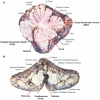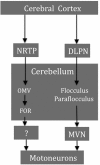Cerebellum and ocular motor control
- PMID: 21909334
- PMCID: PMC3164106
- DOI: 10.3389/fneur.2011.00053
Cerebellum and ocular motor control
Abstract
An intact cerebellum is a prerequisite for optimal ocular motor performance. The cerebellum fine-tunes each of the subtypes of eye movements so they work together to bring and maintain images of objects of interest on the fovea. Here we review the major aspects of the contribution of the cerebellum to ocular motor control. The approach will be based on structural-functional correlation, combining the effects of lesions and the results from physiologic studies, with the emphasis on the cerebellar regions known to be most closely related to ocular motor function: (1) the flocculus/paraflocculus for high-frequency (brief) vestibular responses, sustained pursuit eye movements, and gaze holding, (2) the nodulus/ventral uvula for low-frequency (sustained) vestibular responses, and (3) the dorsal oculomotor vermis and its target in the posterior portion of the fastigial nucleus (the fastigial oculomotor region) for saccades and pursuit initiation.
Keywords: fastigial; flocculus; nodulus; paraflocculus; pursuit; saccade; vermis; vestibular.
Figures






References
-
- Angelaki D. E., Hess B. J. (1994). The cerebellar nodulus and ventral uvula control the torsional vestibulo-ocular reflex. J. Neurophysiol. 72, 1443–1447 - PubMed
LinkOut - more resources
Full Text Sources
Other Literature Sources

